Robotic Manipulation in the Ceramic Industry
Abstract
1. Introduction
2. Materials and Methods
2.1. Mechanical Gripper
2.2. Gripper with Sensorial Feedback
2.3. Vacuum Gripper
2.4. Expansion Gripper
2.5. Dual Gripper
2.6. Covered Ceramic Processes
2.7. Noteworthy Materials
3. Results
3.1. Coffee Saucer Glaze
3.2. Polishing of Coffee Cups
3.2.1. Gripper with Fingers and Sensorial Feedback
3.2.2. Tests with Raw Coffee Cup
4. Discussion
5. Conclusions
Supplementary Materials
Author Contributions
Funding
Data Availability Statement
Conflicts of Interest
References
- Benotsmane, R.; Dudás, L.; Kovács, G. Survey on New Trends of Robotic Tools in the Automotive Industry. In Proceedings of the Vehicle and Automotive Engineering 3, Miskolc, Hungary, 25–26 November 2022; pp. 443–457. [Google Scholar]
- Ribeiro, J.; Lima, R.; Eckhardt, T.; Paiva, S. Robotic Process Automation and Artificial Intelligence in Industry 4.0—A Literature review. Procedia Comput. Sci. 2021, 181, 51–58. [Google Scholar] [CrossRef]
- Tuli, T.B.; Manns, M. Hierarchical Motion Control for Real Time Simulation of Industrial Robots. In Proceedings of the 52nd CIRP Conference on Manufacturing Systems, Ljubljana, Slovenia, 12–14 June 2019. [Google Scholar]
- Weber, A.; Fussler, C.; O’Hanlon; Gierer, R.; Grandjean, E. Psychophysiological effects of repetitive tasks. Ergonomics 1980, 23, 1033–1046. [Google Scholar] [CrossRef] [PubMed]
- Nardo, M.; Forino, D.; Murino, T. The evolution of man–machine interaction: The role of human in Industry 4.0 paradigm. Prod. Manuf. Res. 2020, 8, 20–34. [Google Scholar] [CrossRef]
- Tai, K.; El-Sayed, A.-R.; Shahriari, M.; Biglarbegian, M.; Mahmud, S. State of the Art Robotic Grippers and Applications. Robotics 2016, 5, 11. [Google Scholar] [CrossRef]
- Shintake, J.; Cacucciolo, V.; Floreano, D.; Shea, H. Soft Robotic Grippers. Adv. Mater. 2018, 30, 1707035. [Google Scholar] [CrossRef] [PubMed]
- Zhang, B.; Xie, Y.; Zhou, J.; Wang, K.; Zhang, Z. State-of-the-art robotic grippers, grasping and control strategies, as well as their applications in agricultural robots: A review. Comput. Electron. Agric. 2020, 177, 105694. [Google Scholar] [CrossRef]
- Qian, Z.; QingLong, M.; YongQian, X.; Lin, G. The Robot Intelligent Spraying Glazing System for Sanitary Ceramics Industry. In Journal of Physics: Conference Series, Proceedings of the 2020 International Conference on Advanced Materials and Intelligent Manufacturing & Advanced Steel for Automotive Seminar, Guilin, China, 21–23 August 2020; IOP Publishing Ltd.: Bristol, UK, 2020; Volume 1653. [Google Scholar]
- Ali, H.; Hoi, L.H.; Seng, T.C. Design and Development of Smart Gripper with Vision Sensor for Industrial Applications. In Proceedings of the 2011 Third International Conference on Computational Intelligence, Modelling & Simulation, Langkawi, Malaysia, 20–22 September 2011. [Google Scholar]
- Monkman, G. Robot Grippers. Assem. Autom. 2006, 29. [Google Scholar] [CrossRef]
- Samadikhoshkho, Z.; Zareinia, K.; Janabi-Sharifi, F. A Brief Review on Robotic Grippers Classifications. In Proceedings of the IEEE Canadian Conference of Electrical and Computer Engineering (CCECE), Edmonton, AB, Canada, 5–8 May 2019. [Google Scholar]
- Hu, Z.; Wan, W.; Harada, K. Designing a Mechanical Tool for Robots With Two-Finger Parallel Grippers. arXiv 2019, arXiv:1902.09150. [Google Scholar] [CrossRef]
- Hogrevea, S.; Priggea, M.; Köbischa, K.O.; Tracht, K. Encapsulation of sensory gripper fingers with silicone rubber. Procedia CIRP 2020, 91, 439–444. [Google Scholar] [CrossRef]
- Poveda, A.R. Myoelectric Prostheses with Sensorial Feedback. In MEC’02 the Next Generation, Proceedings of the 2002 MyoElectric Controls/Powered Prosthetics Symposium, Fredericton, NB, Canada, 21–23 August 2002; University of New Brunswick: Fredericton, NB, Canada, 2002. [Google Scholar]
- Belzunce, A.; Li, M.; Handroos, H. Control system design of a teleoperated omnidirectional mobile robot using ROS. In Proceedings of the 2016 IEEE 11th Conference on Industrial Electronics and Applications (ICIEA), Hefei, China, 5–7 June 2016; pp. 1283–1287. [Google Scholar]
- Gabriel, F.; Fahning, M.; Meiners, J.; Dietrich, F.; Dröder, K. Modeling of vacuum grippers for the design of energy efficient vacuum-based handling processes. Prod. Eng. Res. Devel. 2020, 14, 545–554. [Google Scholar] [CrossRef]
- Kumar, R.; Yadav, H.; Gupta, V.; Khatait, J.P. Flexure based gripper to grasp hollow objects by internal surface interaction. Proc. Inst. Mech. Eng. Part C J. Mech. Eng. Sci. 2022, 236, 4085–4092. [Google Scholar] [CrossRef]
- Sriskandarajah, C.; Shetty, B. A review of recent theoretical development in scheduling dual-gripper robotic cells. Int. J. Prod. Res. 2018, 56, 817–847. [Google Scholar] [CrossRef]
- Aksoy, G.; Polat, H.; Polat, M.; Coskun, G. Effect of various treatment and glazing (coating) techniques on the roughness and wettability of ceramic dental restorative surfaces. Colloids Surf. B Biointerfaces 2006, 53, 254–259. [Google Scholar] [CrossRef] [PubMed]
- Li, L.G.; Zhuo, Z.Y.; Kwan, A.K.H.; Zhang, T.S.; Lu, D.G. Cementing efficiency factors of ceramic polishing residue in compressive strength and chloride resistance of mortar. Powder Technol. 2020, 367, 163–171. [Google Scholar] [CrossRef]
- Selvamani, S.K.; Samykano, M.; Subramaniam, S.R.; Ngui, W.K.; Kadirgama, K.; Kanagaraj, G.; Idris, M.S. 3D printing: Overview of ABS evolvement. AIP Conf. Proc. 2019, 2059, 020041. [Google Scholar]



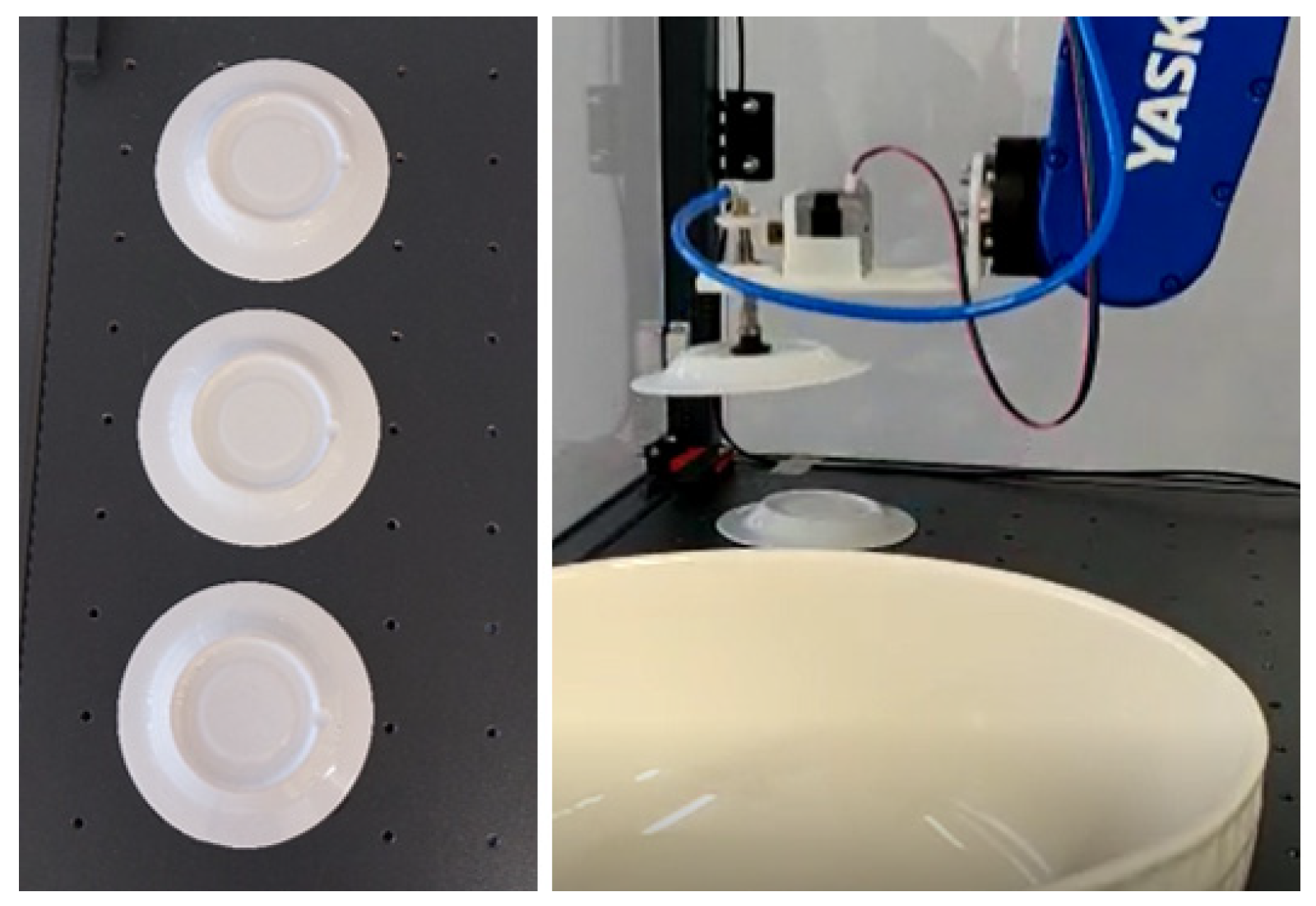

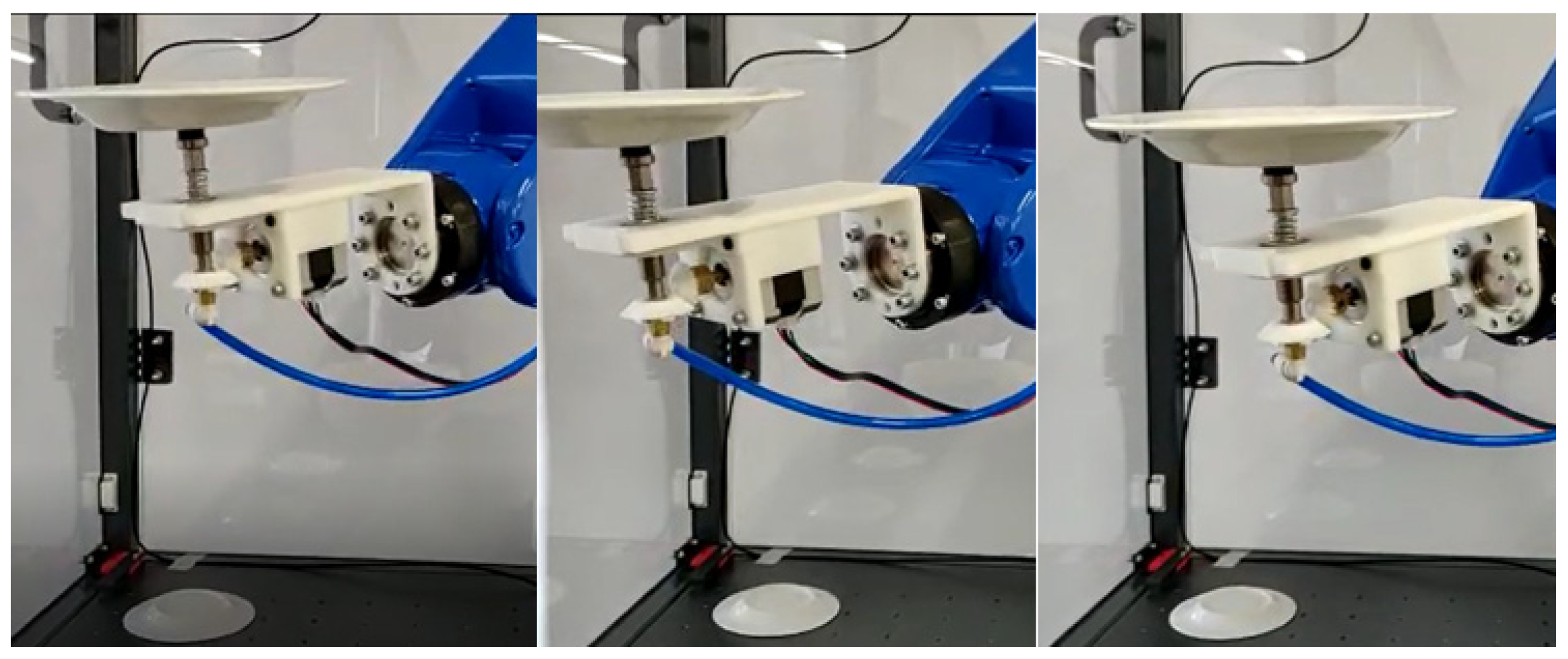

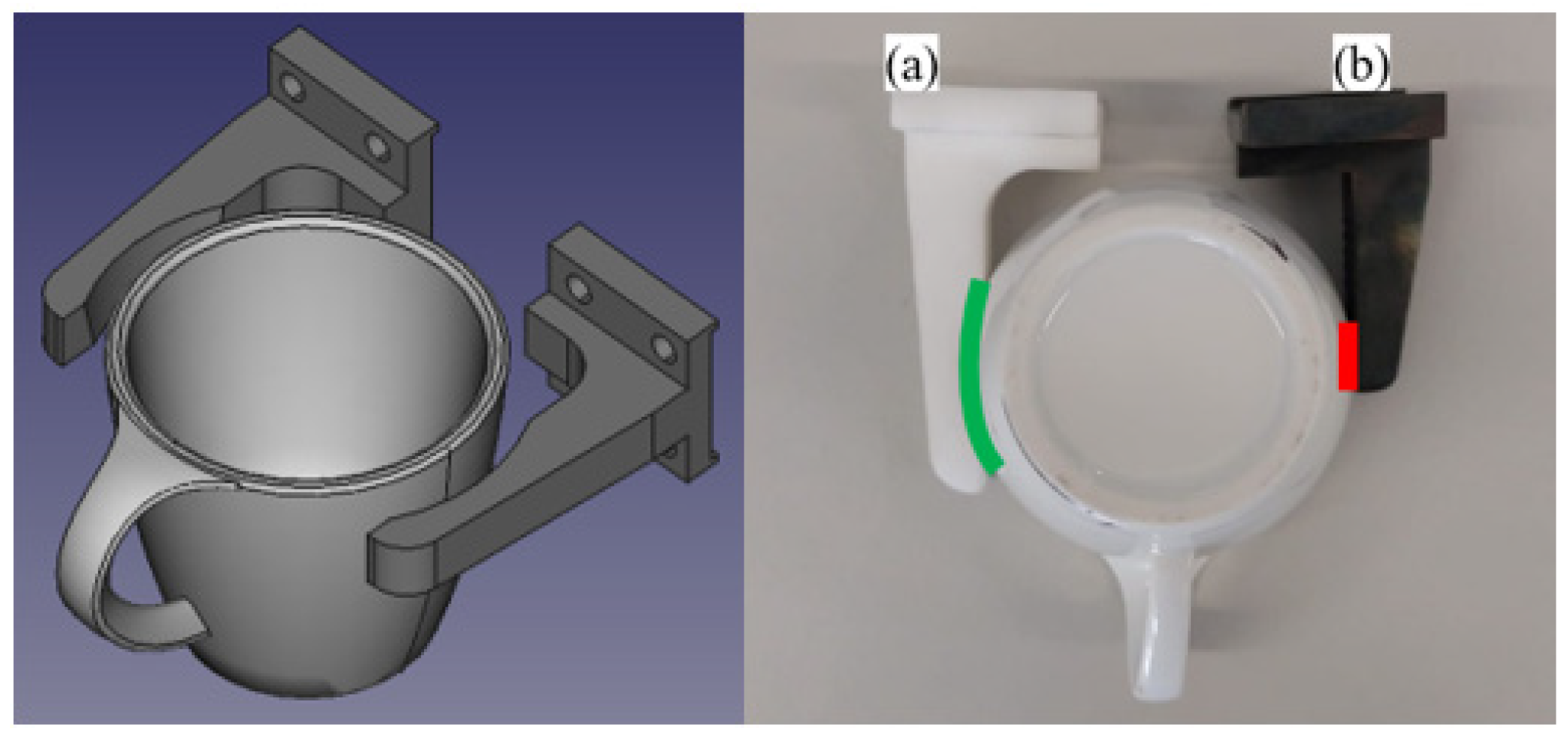
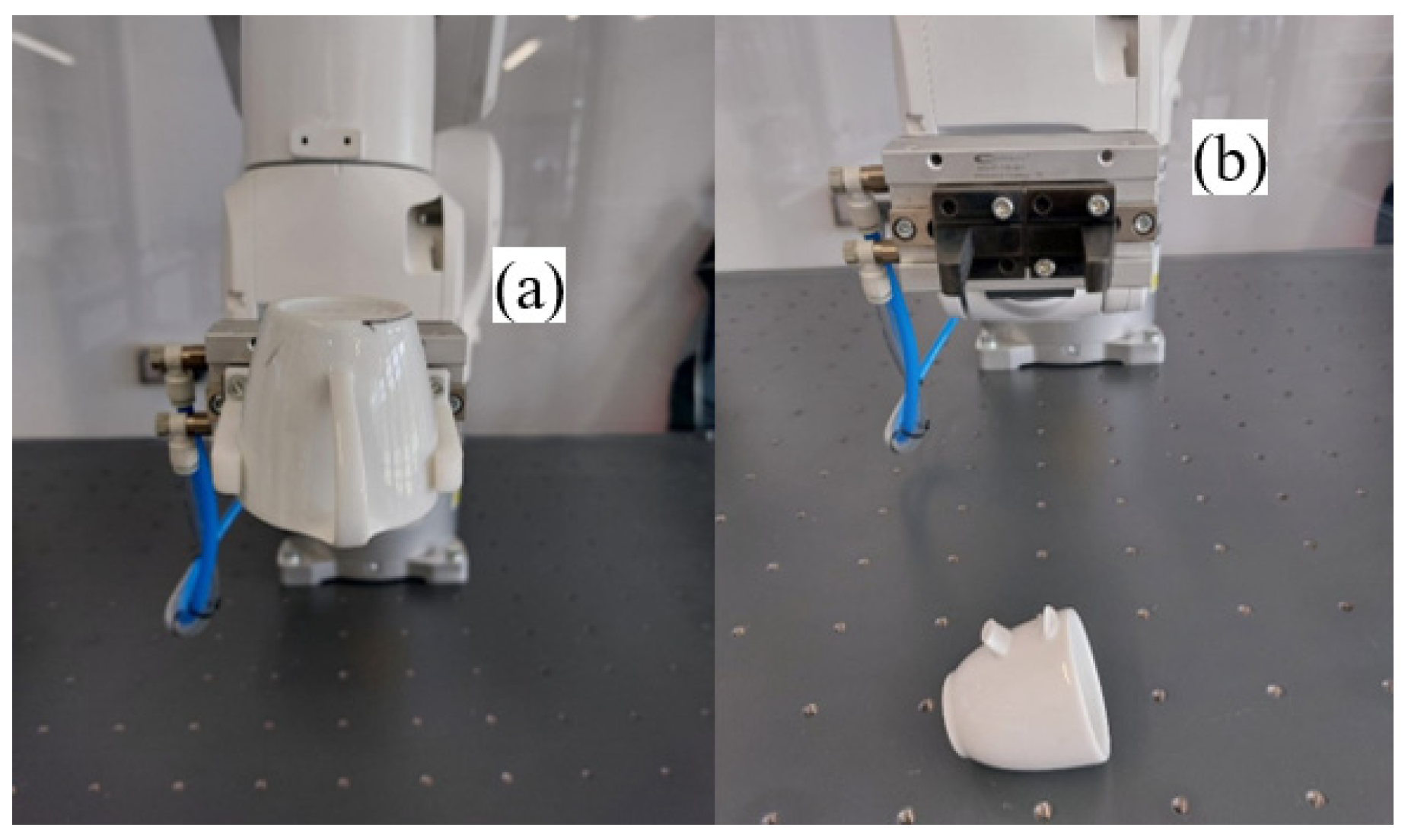
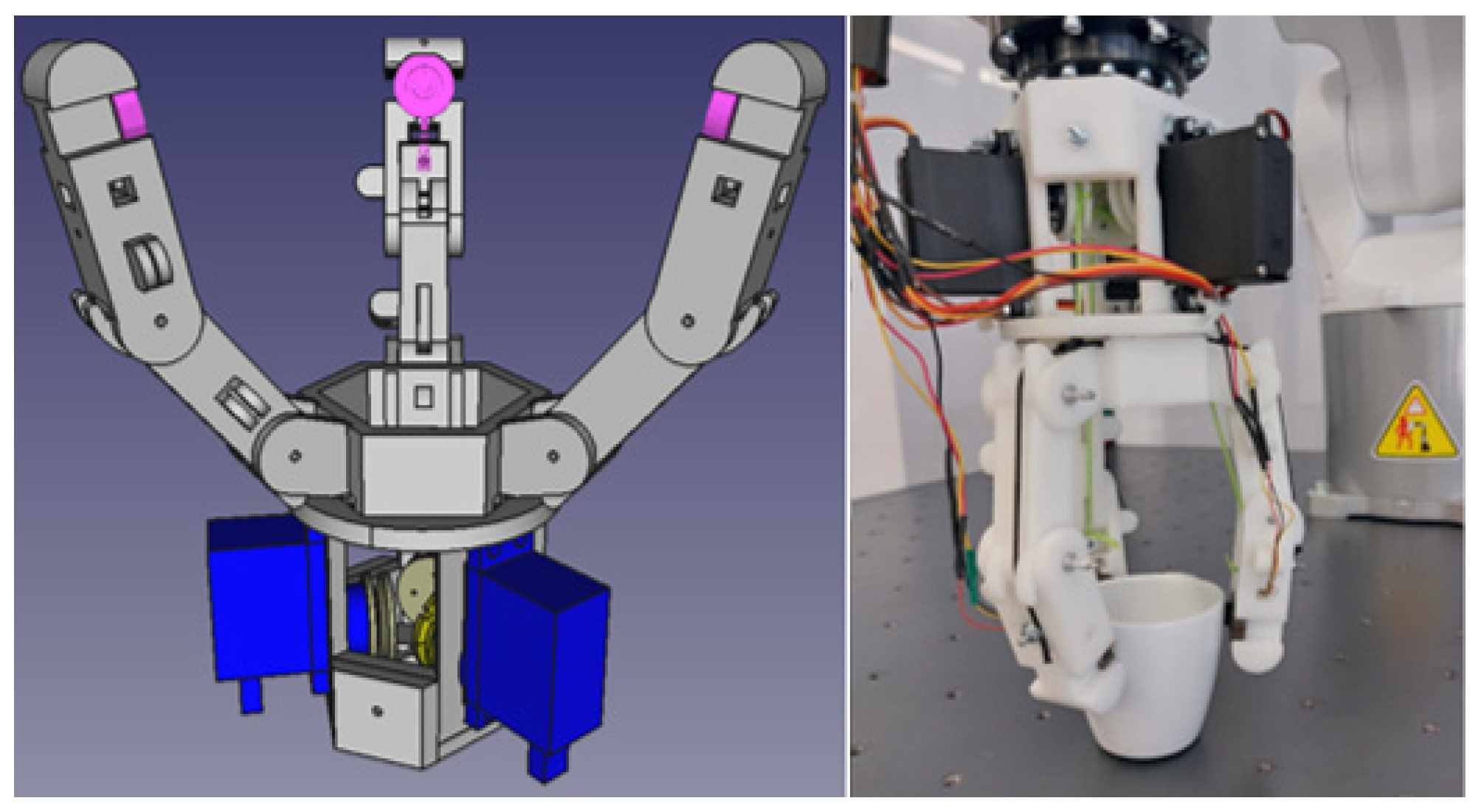
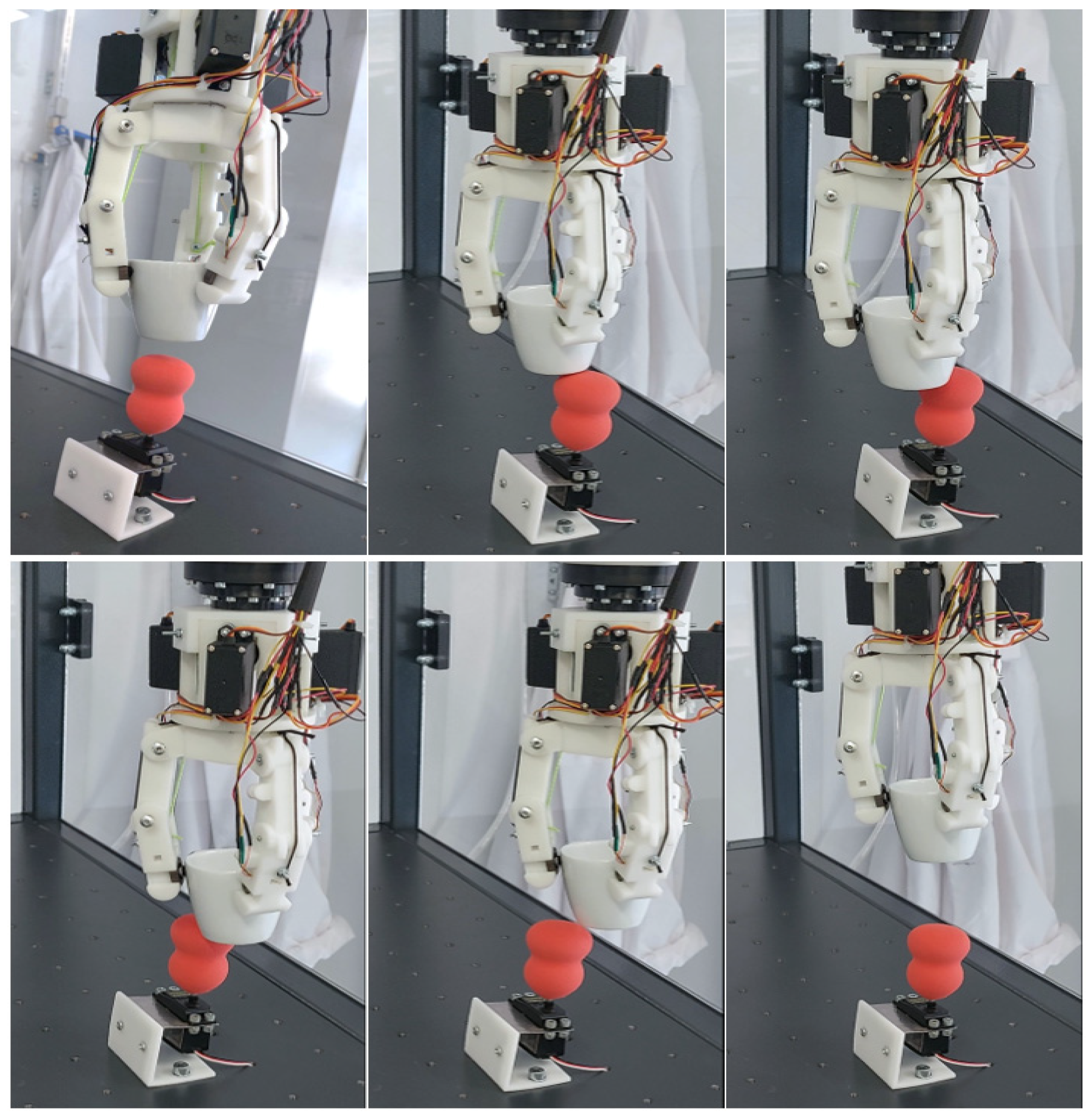


| Load on Fingers (N) | Limits Applied (N) | |||
|---|---|---|---|---|
| C1 | C2 | C3 | Minimum Limit | Maximum Limit |
| 1.744 | 1.744 | 1.882 | 1.568 | 3.136 |
| 0.941 | 0.804 | 0.941 | 0.510 | 1.020 |
| 1.882 | 1.345 | 1.882 | 1.323 | 2.646 |
| 0.804 | 0.666 | 0.941 | 0.559 | 1.118 |
| 0.804 | 0.804 | 0.666 | 0.441 | 0.882 |
| 0.529 | 0.529 | 0.529 | 0.363 | 0.726 |
| Load on Fingers (N) | Limit and State of Cup | |||
|---|---|---|---|---|
| C1 | C2 | C3 | Minimum Limit (N) | Cup |
| 0.519 | 0.461 | 0.461 | 0.412 | OK |
| 0.892 | 0.843 | 0.872 | 0.833 | OK |
| 1.294 | 1.284 | 1.254 | 1.225 | - |
| 1.784 | 1.784 | 1.686 | 1.617 | - |
| 2.019 | 2.097 | 2.244 | 2.009 | - |
| 2.568 | 2.568 | 2.568 | 2.401 | - |
| 3.097 | 3.116 | 3.087 | 2.793 | - |
| 3.548 | 3.636 | 3.518 | 2.185 | - |
| 3.891 | 3.646 | 3.891 | 3.577 | - |
| 4.165 | 4.243 | 4.155 | 3.969 | - |
| 4.577 | 4.724 | 4.577 | 4.361 | BROKE |
Publisher’s Note: MDPI stays neutral with regard to jurisdictional claims in published maps and institutional affiliations. |
© 2022 by the authors. Licensee MDPI, Basel, Switzerland. This article is an open access article distributed under the terms and conditions of the Creative Commons Attribution (CC BY) license (https://creativecommons.org/licenses/by/4.0/).
Share and Cite
Torres, R.; Ferreira, N. Robotic Manipulation in the Ceramic Industry. Electronics 2022, 11, 4180. https://doi.org/10.3390/electronics11244180
Torres R, Ferreira N. Robotic Manipulation in the Ceramic Industry. Electronics. 2022; 11(24):4180. https://doi.org/10.3390/electronics11244180
Chicago/Turabian StyleTorres, Rogério, and Nuno Ferreira. 2022. "Robotic Manipulation in the Ceramic Industry" Electronics 11, no. 24: 4180. https://doi.org/10.3390/electronics11244180
APA StyleTorres, R., & Ferreira, N. (2022). Robotic Manipulation in the Ceramic Industry. Electronics, 11(24), 4180. https://doi.org/10.3390/electronics11244180







